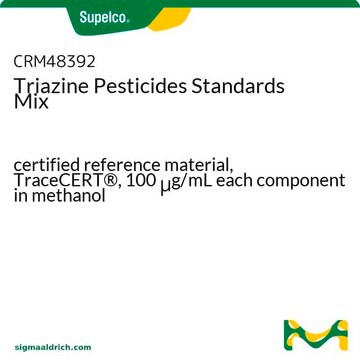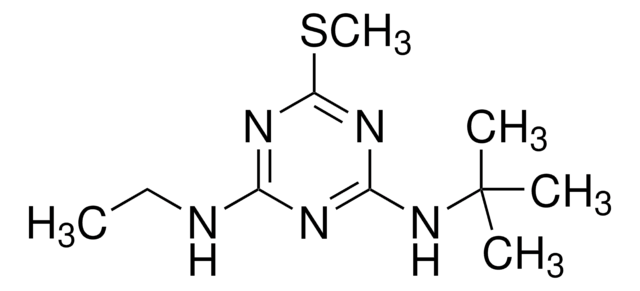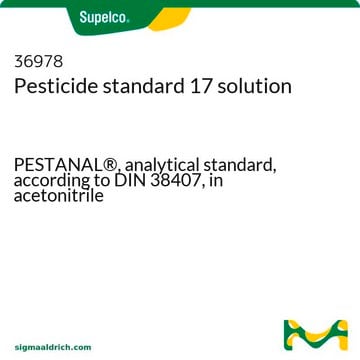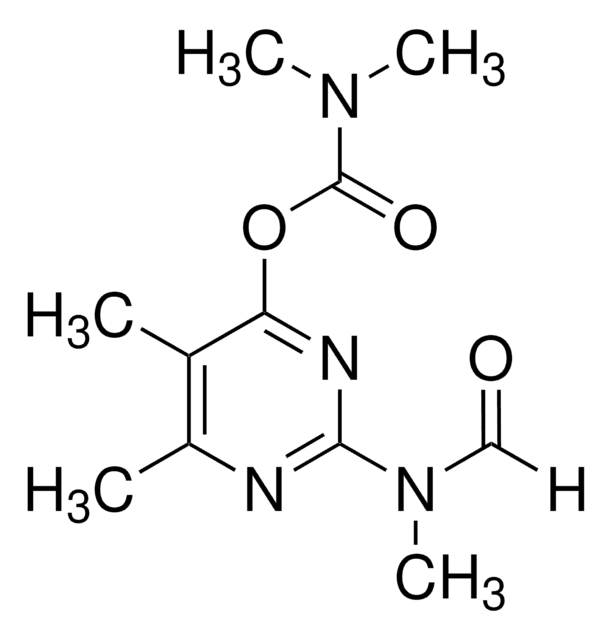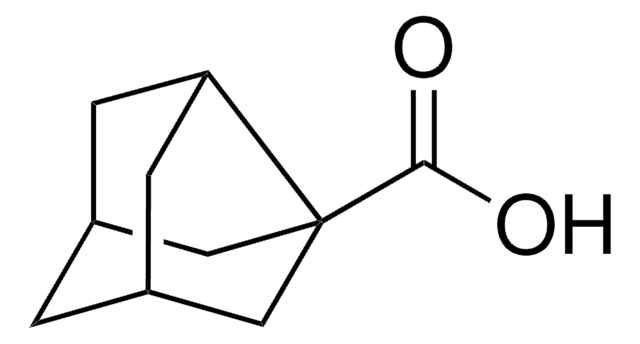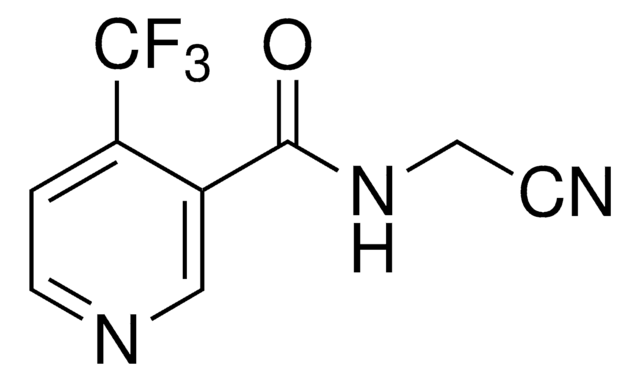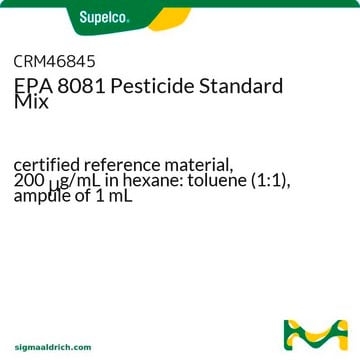All Photos(1)
About This Item
Empirical Formula (Hill Notation):
C9H16ClN5
CAS Number:
Molecular Weight:
229.71
Beilstein:
16028
EC Number:
MDL number:
UNSPSC Code:
41116107
PubChem Substance ID:
NACRES:
NA.24
Recommended Products
grade
analytical standard
Quality Level
product line
PESTANAL®
shelf life
limited shelf life, expiry date on the label
technique(s)
HPLC: suitable
gas chromatography (GC): suitable
application(s)
agriculture
environmental
format
neat
SMILES string
CCNc1nc(Cl)nc(n1)N(CC)CC
InChI
1S/C9H16ClN5/c1-4-11-8-12-7(10)13-9(14-8)15(5-2)6-3/h4-6H2,1-3H3,(H,11,12,13,14)
InChI key
HFBWPRKWDIRYNX-UHFFFAOYSA-N
Looking for similar products? Visit Product Comparison Guide
General description
Trietazine is a triazine herbicide primarily applied as pre- and post- emergent chemical for the control of annual and perennial grass and broad-leaved weeds.
Application
Refer to the product′s Certificate of Analysis for more information on a suitable instrument technique. Contact Technical Service for further support.
Trietazine may be used as a herbicide reference standard for the determination of the analyte:
- In milk samples based on microwave-assisted ionic liquid microextraction (MAILME) coupled with high-performance liquid chromatography (HPLC).
- In traditional Chinese medicines (TCMs) by liquid chromatography combined with ultra fast electrospray ionization tandem mass spectrometry (UFLC-ESI-MS/MS) method.
Legal Information
PESTANAL is a registered trademark of Merck KGaA, Darmstadt, Germany
Signal Word
Warning
Hazard Statements
Precautionary Statements
Hazard Classifications
Acute Tox. 4 Oral - Aquatic Acute 1
Storage Class Code
11 - Combustible Solids
WGK
WGK 3
Flash Point(F)
Not applicable
Flash Point(C)
Not applicable
Personal Protective Equipment
dust mask type N95 (US), Eyeshields, Gloves
Choose from one of the most recent versions:
Already Own This Product?
Find documentation for the products that you have recently purchased in the Document Library.
Süleyman Aşır et al.
Electrophoresis, 36(23), 2888-2895 (2015-08-08)
Trietazine was selectively separated from aqueous solution containing the competitor molecule cyanazine, which is similar in size and shape to the template molecule. Structural features of the molecularly imprinted column were figured out by SEM. The influence of the mobile-phase
E L Balabanova et al.
Gigiena i sanitariia, (8)(8), 50-52 (1990-08-01)
The study was undertaken to analyze the capacity of organic active chlorotriazine pigments to make contact with blood serum proteins. It was established that pigment toxicity was inversely correlated to the capacity of making contact with blood serum proteins (r
Determination of phenylurea and triazine herbicides in milk by microwave assisted ionic liquid microextraction high-performance liquid chromatography.
Gao S, et al.
Talanta, 82(4), 1371-1377 (2010)
B A Kurliandskiĭ et al.
Gigiena truda i professional'nye zabolevaniia, (3)(3), 15-18 (1990-01-01)
The article presents research data related to the biotransformation, intoxication mechanisms and pathogenic properties of chlortriazine dye-stuffs. All the dye-stuffs studies were characterized by similar intoxication properties and pathogenesis, and were related to the 3rd class of hazardous substances. The
Tami S McMullin et al.
Toxicology in vitro : an international journal published in association with BIBRA, 21(3), 492-501 (2006-12-26)
This study estimated the kinetic constants for oxidative metabolism of atrazine (ATRA) and its chlorotriazine (Cl-TRI) metabolites, 2-chloro-4-ethylamino-6-amino-1,3,5-triazine (ETHYL), 2-chloro-4-amino-6-isopropylamino-1,3,5-triazine (ISO), and diaminochlorotriazine (DACT), using freshly isolated rat hepatocytes. Hepatocytes were incubated with 1.74, 44, 98, and 266 microM ATRA.
Our team of scientists has experience in all areas of research including Life Science, Material Science, Chemical Synthesis, Chromatography, Analytical and many others.
Contact Technical Service